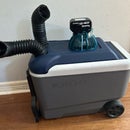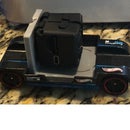Introduction: LED Pantry Lights
The pantry at our house was incredibly dark, with just one light overhead. With three people putting things away in different places in the pantry, we were knee deep in Teddy Grahams and Mac-N-Cheese without realizing there were boxes hidden in the corners.
For about $40, I added LED strip lights to the four lowest shelves making everything in the pantry visible as soon as the door is opening. For an additional $35, I lit my entire garage with a similar system. This was a very simple project requiring hardly anything in the way of tools or expertise. The whole thing took about an hour.
Step 1: Gather Materials and Tools
The major materials in this project were acquired on Ebay.
The strip lights (5M roll $4)
The closet switch ($15 They do carry these at some Home Depot stores, but not the one closest to me)
Vinyl Tile Edging ($5 each, needed two)
Old work electrical box ($5)
Romex Wire for power (I needed about 10")
Wire for Closet Switch and strip lights (I used red and black speaker wire)
12V power supply (I used a 12V 2A old laptop power supply)
Outlet and Cover (I had an old one in the garage $5)
Screws to attach tile edging to shelves #4 pan head, 3/8" (I had these from an old project)
Tools:
Screw Driver
Wire Strippers
Saw for outlet/switch
Fish Tape (possibly if you have to feed the wire up the wall)
Soldering Iron/Solder
Drill/bit for feeding wire through shelves
Staple gun and staples
Step 2: Cut Tile Edging/lights to Lengths and Attach
Cutting the edging is self explanatory, but the LED lights strip can only be cut at intervals. On the ones I used that is every three LEDs. The tile edging was cut in half, then I used scissors to cut the LED strip into lengths approximately the same length. I have about 1" overhang on the side furthest form the power connection.
The LED strip comes with adhesive backing. Wipe the inside of the vinyl edge strip, then peel and stick. It doesn't have to be perfect, there is enough light output that you cannot see the individual LEDs.
Step 3: Solder Power Connections and Test All Strips
I used the speaker wire because the red and black are fused so I wouldn't risk destroying the strip or the power supply. I tinned the connection points on strips, and wire. This part was easier than anticipated as well.
Using the same power supply I used for the lights, I tested each one as a I went to make sure everything worked as anticipated.
Step 4: Attach Edging and Feed Wire to Outlet
Next, attach each piece of tile edging backwards and upside down...so the finish side (almond or pebbly beach in my case) if facing you from the bottom of the shelf. Again, these is enough light that these don't need to be perfect, but I tried to get it as centered as possible. With the small screws, it is possible to go right through the larger parts of the vinyl without cracking it.
After each piece of edging was attached, I drilled through the shelves to feed the wire close to the outlet. I also stapled the wire in place on the underside of each shelf, and down the walls.
Step 5: Cut and Install Outlet and Switch
Installing the outlet and switch are pretty simple. I had a gang light switch almost exactly opposite of where I wanted the outlet that had hot power to it all the time. Locate and cut the holes for the boxes. I had to recess the closet switch just a little with a chisel because the gap was very small to begin with. That won't need to happen in every case. From there, I split the outlet by removing the brass tab on the hot side as seen in the picture then delivered the power to the lower outlet only. From the lower outlet, I ran a wire to my closet switch then back to the top outlet. The idea is that the power will be cut to the top outlet when the door is shut, and active when I it is open. Test these connections with a power tester or anything that plugs in.
The added bonus of doing this now is that the final wire connections for the LEDs can all be done in the pantry without the need for an extension cord for the soldering iron.
Step 6: Connect Your LED Wires to Your Power Supply
I was lucky enough to find a barrel connector at Fry's that fit my power supply. Had I not been able to do that, it would have been a matter of splitting the positive and negative and soldering directly to the wires. I used heat shrink and solder to pair the wires, the solder all four to one lead for positive and one for negative.
These were fit into the connector, which was then plugged it.
Step 7: Test the Switch, Button It Up and Admire Your Groceries
Now use your fingers to test the switch, On, OFF, On, OFF, On, OFF. Then close the door, open the door, close the door, open the door. Smile and repeat.
Using a laptop power supply means there is a couple second delay from when the power is supplied and the lights come on, but not enough time to forget what you are looking for.
Step 8: Garage Lights
I purchased eight of these 5M strips for $26 shipped. I used six of the remaining strips as I saw in this video on Youtube:
The only changes I made were soldering directly to the strips, cutting the flashing down to 8' lengths, and not using additional doublesided tape (so far so good). I actually did this project first, before cutting into the pantry walls. I attached each piece of flashing to the joists with drywall screws.
In my case, there was a single incandescent bulb connected to a light switch. With the additional $35 in wire, power supply and flashing, I have completely illuminated my garage. I got a 20A power supply and am only using 12A, so I can and will add a few more strands in the coming months. The amount of light is amazing.





